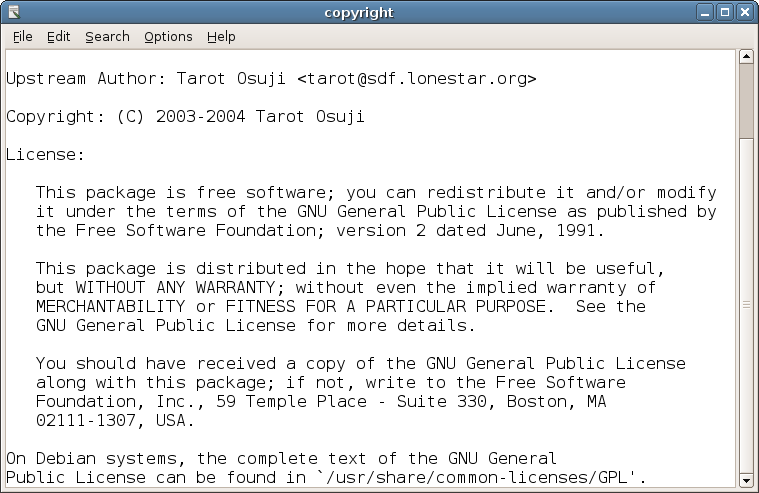|
Plan9port
Plan 9 from User Space (also plan9port or p9p) is a port of many Plan 9 from Bell Labs libraries and applications to Unix-like operating systems. Currently it has been tested on a variety of operating systems, including Linux, macOS, FreeBSD, NetBSD, OpenBSD, Solaris and SunOS. The project's name is a reference to the 1950s Ed Wood film ''Plan 9 from Outer Space''. A number of key applications have been ported, as have programs used by the system itself, along with the requisite libraries from Plan 9. All of these have been made to work on top of a Unix-like environment instead of their native Plan 9. Some of the most significant ported components are: * rc – The Plan 9 shell * sam – A text editor * acme – A combination of text editor and graphical shell especially useful to programmers * mk – A tool for building software, analogous to the traditional Unix make utility * plumber – An interprocess messaging facility * Venti Venti may refer to: * Venti (software), a ... [...More Info...] [...Related Items...] OR: [Wikipedia] [Google] [Baidu] |
Linux
Linux ( ) is a family of open source Unix-like operating systems based on the Linux kernel, an kernel (operating system), operating system kernel first released on September 17, 1991, by Linus Torvalds. Linux is typically package manager, packaged as a Linux distribution (distro), which includes the kernel and supporting system software and library (computing), libraries—most of which are provided by third parties—to create a complete operating system, designed as a clone of Unix and released under the copyleft GPL license. List of Linux distributions, Thousands of Linux distributions exist, many based directly or indirectly on other distributions; popular Linux distributions include Debian, Fedora Linux, Linux Mint, Arch Linux, and Ubuntu, while commercial distributions include Red Hat Enterprise Linux, SUSE Linux Enterprise, and ChromeOS. Linux distributions are frequently used in server platforms. Many Linux distributions use the word "Linux" in their name, but the Free ... [...More Info...] [...Related Items...] OR: [Wikipedia] [Google] [Baidu] |
Acme (text Editor)
Acme is a text editor and graphical shell from the Plan 9 from Bell Labs operating system, designed and implemented by Rob Pike. It can use the Sam command language. The design of the interface was influenced by Oberon. It is different from other editing environments in that it acts as a 9P server. A distinctive element of the user interface is mouse chording. Overview Acme can be used as a mail and news reader, or as a frontend to wikifs. These applications are made possible by external components interacting with acme through its file system interface. Rob Pike has mentioned that the name "Acme" was suggested to him by Penn Jillette of Penn & Teller during a movie night at Times Square when he asked for a suitable name for a text editor that does "everything". Ports A port to the Inferno operating system is part of Inferno's default distribution. Inferno can run as an application on top of other operating systems, allowing Inferno's port of acme to be used on most op ... [...More Info...] [...Related Items...] OR: [Wikipedia] [Google] [Baidu] |
Sam (text Editor)
Sam is a multi-file text editor based on structural regular expressions. It was originally designed in the early 1980s at Bell Labs by Rob Pike with the help of Ken Thompson and other Unix developers for the Blit windowing terminal running on v9 Unix; it was later ported to other systems. Sam follows a classical modular Unix aesthetic. It is internally simple, its power leveraged by the composability of a small command language and extensibility through shell integration. Design and features Sam is designed as two synchronous programs: a command interpreter and a mouse-oriented bitmap windowing interface. The interpreter's command set is modeled after the UNIX editor ed and may be used to operate the editor from a standard text terminal. By default, however, Sam presents its own graphical user interface (GUI) window, ''samterm'', which additionally allows point-and-click operations through pop-up context menus. This two-process structure allowed sam to access files on network ... [...More Info...] [...Related Items...] OR: [Wikipedia] [Google] [Baidu] |
Rc (Unix Shell)
rc (for "run commands") is the command-line interpreter for Version 10 Unix and Plan 9 from Bell Labs operating systems. It resembles the Bourne shell, but its syntax is somewhat simpler. It was created by Tom Duff, who is better known for an unusual C (programming language), C programming language construct ("Duff's device"). A port of the original rc to Unix is part of Plan 9 from User Space. A rewrite of rc for Unix-like operating systems by Byron Rakitzis is also available but includes some incompatible changes. Rc uses C-like control structures instead of the original Bourne shell's ALGOL-like structures, except that it uses an if not construct instead of else, and has a Bourne-like for loop to iterate over lists. In rc, all variables are lists of strings, which eliminates the need for constructs like $@, "$@". Variables are not re-split when expanded. The language is described in Duff's paper. Influences es ''es'' (for "extensible shell") is an open source, command li ... [...More Info...] [...Related Items...] OR: [Wikipedia] [Google] [Baidu] |
ANSI C
ANSI C, ISO C, and Standard C are successive standards for the C programming language published by the American National Standards Institute (ANSI) and ISO/IEC JTC 1/SC 22/WG 14 of the International Organization for Standardization (ISO) and the International Electrotechnical Commission (IEC). Historically, the names referred specifically to the original and best-supported version of the standard (known as C89 or C90). Software developers writing in C are encouraged to conform to the standards, as doing so helps portability between compilers. History and outlook The first standard for C was published by ANSI. Although this document was subsequently adopted by ISO/IEC and subsequent revisions published by ISO/IEC have been adopted by ANSI, "ANSI C" is still used to refer to the standard. While some software developers use the term ISO C, others are standards-body neutral and use Standard C. Informal specification: K&R C (''C78'') Informal specification in 1978 (Brian Kernig ... [...More Info...] [...Related Items...] OR: [Wikipedia] [Google] [Baidu] |
Plan 9 From Outer Space
''Plan 9 from Outer Space'' is a 1957 American Independent film, independent science fiction film, science fiction-horror film produced, written, directed, and edited by Ed Wood. The film was shot in black-and-white in November 1956 and had a preview screening on March 15, 1957, at the Carlton Theatre in Los Angeles under the title ''Grave Robbers from Outer Space''. Retitled ''Plan 9 from Outer Space'', it went into general release in July 1958 in Virginia, Texas, and several other Southern states, before being sold to television in 1961.Rudolph Grey, ''Nightmare of Ecstasy: The Life and Art of Edward D. Wood, Jr.'' (1992). pg. 197. ISBN 978-0-922915-24-8. The film stars Gregory Walcott, Mona McKinnon, Tor Johnson, and "Vampira" (Maila Nurmi), and is narrated by The Amazing Criswell, Criswell. It also posthumously bills Bela Lugosi (before Lugosi's death in August 1956, Wood had shot silent footage of Lugosi for another, unfinished film, which was inserted into ''Plan 9''). ... [...More Info...] [...Related Items...] OR: [Wikipedia] [Google] [Baidu] |
Venti (software)
Venti is a network storage system that permanently stores data blocks. A 160-bit SHA-1 hash of the data (called ''score'' by Venti) acts as the address of the data. This enforces a ''write-once'' policy since no other data block can be found with the same address: the addresses of multiple writes of the same data are identical, so it is highly likely that duplicate data is easily identified and the data block is stored only once. Data blocks cannot be removed, making it ideal for permanent or backup storage. Venti is typically used with Fossil to provide a file system with permanent snapshots. History Venti was designed and implemented by Sean Quinlan and Sean Dorward at Bell Labs. It appeared in the Plan 9 distribution in 2002. Development has been continued by Russ Cox who has reimplemented most of the server, written a library for creating datastructures (files, directories and meta-data) to store in Venti and implemented optimizations. Venti is available both in ... [...More Info...] [...Related Items...] OR: [Wikipedia] [Google] [Baidu] |
Plumber (Plan 9)
A plumber is a tradesperson who specializes in installing and maintaining systems used for potable (drinking) water, hot-water production, sewage and drainage in plumbing systems.Employment and Occupations in the Skilled Trades in Michigan , Michigan Department of Technology, Management, and Budget, Bureau of Labor Market Information and Strategic Initiatives (June 2013). History The origin of the word "plumber" dates from the . Roman roofs used lead in conduits and drain pipes and some were also covered with lead; lead was also used for |
Make (software)
In software development, Make is a command-line interface software tool that performs actions ordered by configured dependencies as defined in a configuration file called a ''makefile''. It is commonly used for build automation to build executable code (such as a program or library) from source code. But, not limited to building, Make can perform any operation available via the operating system shell. Make is widely used, especially in Unix and Unix-like operating systems, even though many competing technologies and tools are available, including similar tools that perform actions based on dependencies, some compilers and interactively via an integrated development environment. In addition to referring to the original Unix tool, Make is also a technology since multiple tools have been implemented with roughly the same functionality including similar makefile syntax and semantics. Origin Stuart Feldman created Make while at Bell Labs. An early version was completed in ... [...More Info...] [...Related Items...] OR: [Wikipedia] [Google] [Baidu] |
Text Editor
A text editor is a type of computer program that edits plain text. An example of such program is "notepad" software (e.g. Windows Notepad). Text editors are provided with operating systems and software development packages, and can be used to change files such as configuration files, documentation files and programming language source code. Plain text and rich text There are important differences between plain text (created and edited by text editors) and rich text (such as that created by word processors or desktop publishing software). Plain text exclusively consists of character representation. Each character is represented by a fixed-length sequence of one, two, or four bytes, or as a variable-length sequence of one to four bytes, in accordance to specific character encoding conventions, such as ASCII, ISO/IEC 2022, ISO/IEC 2022, Shift JIS, UTF-8, or UTF-16. These conventions define many printable characters, but also whitespace character, non-printing characters th ... [...More Info...] [...Related Items...] OR: [Wikipedia] [Google] [Baidu] |
Shell (computing)
An operating system shell is a computer program that provides relatively broad and direct access to the system on which it runs. The term ''shell'' refers to how it is a relatively thin Abstraction layer, layer around an operating system. A shell is generally a command-line interface (CLI) program although some graphical user interface (GUI) programs are arguably classified as shells too. Overview Operating systems provide various services to their users, including File manager, file management, Process (computing), process management (running and terminating Application program, applications), batch processing, and operating system monitoring and configuration. Most operating system shells are not ''direct'' interfaces to the underlying Kernel (operating system), kernel, even if a shell communicates with the user via peripheral devices attached to the computer directly. Shells are actually special applications that use the kernel API in just the same way as it is used by ot ... [...More Info...] [...Related Items...] OR: [Wikipedia] [Google] [Baidu] |




